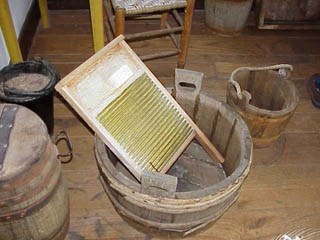
There are two major ways to wash clothes; by letting water flow over and through them and by abrasion. Both were used in early times and also now. An easy, primitive way to wash is to put clothes in a large basket, fasten the basket securely in place in a flowing stream and let nature do the rest. There never was a cleaner wash. However, if one did not have a convenient stream that was deep enough the alternative was to bring the water to some other place and use a washboard or else pound the cloths on stones at the stream bank and then rinse them in the stream. One other method was to put water in a large cauldron and boil the clothes in it; fine for tightly woven goods but not possible for hand knit socks and sweaters. Therefore, such items have to be carefully sloshed in cold water, and squeezed out extremely carefully. The methods that laundresses in the United States Army used included both boiling and the use of washboards. Cotton or linen items like shirts, underwear, and socks were scrubbed on washboards and then boiled, which sanitized them at the same time. Over the years, there have been several types of washboards. One standard type is zinc coated base metal. Some were coated with brass, and glass washing surfaced ones were also widely sold for a time. Later, in the 1880s and 1890s, washboard surfaces were even made of what was called granite ware-colored blue and gray. We now call it baked enamel. Wooden washboards were used in the 1840s. A large piece of wood was carved into the corrugated shape of a rubbing surface. These are not so well known as the metal boards because the constant wetting wore them out faster so there are not many that have survived. A few are still in the Kansas-Oklahoma area. The laundresses at Fort Scott would have used wooden washboards. Instructions for these washboards are pictured below. 

The text for this article was written by park VIP Joan House.
|
Last updated: July 25, 2016

